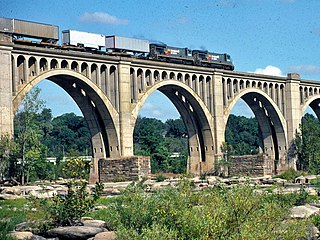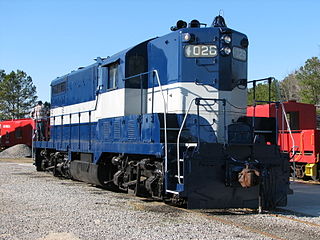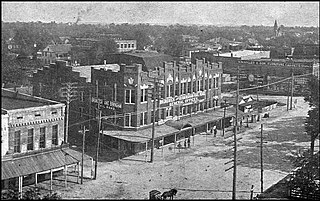
The Seaboard System Railroad, Inc. was a US Class I railroad that operated from 1982 to 1986.

The Georgia Railroad and Banking Company also seen as "GARR", was a historic railroad and banking company that operated in the U.S. state of Georgia. In 1967 it reported 833 million revenue-ton-miles of freight and 3 million passenger-miles; at the end of the year it operated 331 miles (533 km) of road and 510 miles (820 km) of track.

The Atlanta, Birmingham and Coast Railroad was organized in 1926 to replace the bankrupt Atlanta, Birmingham and Atlantic Railway. The AB&C was controlled by the Atlantic Coast Line Railroad, which owned a majority of the stock. In 1944 it reported 763 million net ton-miles of revenue freight and 33 million passenger-miles; at the end of that year it operated 639 miles of road and 836 miles of track.

The Waycross Air Line Railroad, chartered in 1887, was an air-line railroad in Georgia. It began operations between Waycross and Sessoms in 1890. In 1901, the railroad had extended as far as Fitzgerald, Georgia, at which time its charter was amended for an extension to Birmingham, Alabama, and it was renamed the Atlantic and Birmingham Railroad. That company purchased the Tifton and Northeastern Railroad and Tifton, Thomasville and Gulf Railway on December 3, 1903, changing its name to the Atlantic and Birmingham Railway. In 1906, the Atlantic and Birmingham Railway was in turn purchased by the Atlanta, Birmingham and Atlantic Railway, which continued expansion towards Birmingham.
The Tifton and Northeastern Railroad was a railroad running from Tifton, Georgia northeast to Fitzgerald, Georgia, a distance of 25 miles. It was built in the late 1800s and it later became part of the Atlanta, Birmingham and Atlantic Railway and Atlantic Coast Line Railroad networks.

The Brunswick and Birmingham Railroad (B&B) was a railroad in southeastern United States. Its main route ran from Brunswick, Georgia to Sessoms.
The Atlanta and Birmingham Air Line Railway (A&BAL) was a railroad line running from Atlanta, Georgia to Birmingham, Alabama. It eventually ccame under the ownership of the Seaboard Air Line Railroad.
The Brunswick and Western Railroad is a historic railroad in southern Georgia that at its greatest extent ran from Brunswick near the coast to Albany. Segments of the line still exist today. The Brunswick and Florida Railroad ran from Brunswick west to Glenmore, where it would connect with the Atlantic and Gulf Railroad.
The Jesup Subdivision is a railroad line owned and operated by CSX Transportation in Georgia. The line runs from Jesup, Georgia to Folkston, Georgia for a length of 72.7 miles. It notable passes through Waycross, Georgia, a major CSX freight terminal and CSX operates numerous freight trains over the line. The Jesup Subdivision was once a major route for the Atlantic Coast Line Railroad, one of CSX's predecessors.
The Savannah Subdivision is a railroad line owned by CSX Transportation in the U.S. state of Georgia. Through the middle of Savannah, the Savannah Subdivision splits into an east route and a west route. The East Route runs from Savannah, Georgia, to Ogeechee, Georgia, for a total of 15.6 miles (25.1 km). At its north end it continues south from the Charleston Subdivision and the Columbia Subdivision both of the Florence Division and at its south end it continues south as the Nahunta Subdivision. The West Route is located in Savannah, Georgia, and is 9.7 miles (15.6 km) in length. At its north end it branches off of the Savannah Subdivision East Route and at its south end it comes back into the Savannah Subdivision East Route.
CSX Transportation's Atlanta Terminal Subdivision comprises the company's railroad lines and infrastructure operating in and around Atlanta, Georgia. The Atlanta Terminal Subdivision consists of five lines and a number of yards. Most of the lines in the Atlanta Terminal Subdivision date back to the 1800s.
The Lineville Subdivision is a railroad line currently operated by CSX Transportation in Georgia and Alabama. It runs from Parkwood southeast though Lineville, Alabama to Manchester, Georgia, a distance of 179.4 miles (288.7 km). It connects with CSX's Manchester Subdivision and Fitzgerald Subdivision in Manchester.
The Manchester Subdivision is a railroad line currently operated by CSX Transportation in Central Georgia. Its northern terminus is in Peachtree City, where it continues south from the Atlanta Terminal Subdivision. From Peachtree City, it runs for 38.8 miles (62.4 km) south to Manchester, Georgia, where it connects with CSX's Lineville Subdivision and Fitzgerald Subdivision. It is a major north-south route for CSX in Georgia.
The Atlantic Coast Line Railroad's Perry Cutoff was a historic rail line in northern Florida running from Monticello southeast to Perry. The line provided a shortcut through the Big Bend of Florida for rail traffic running between the Midwest and the Tampa Bay area by providing a more direct route and a bypass for the busy rail hub in Jacksonville. It was completed in 1928 to reduce travel times for its passenger trains to the west coast, or Gulf Coast, of Florida during the Florida land boom of the 1920s.
The Waycross Short Line was the unofficial name of a railroad line built by Henry B. Plant that ran from Waycross, Georgia to Jacksonville, Florida on the St. Johns River. The line through Georgia was chartered by Plant as the Waycross and Florida Railroad and the Florida segment was chartered as the East Florida Railway. The line crossed the Georgia/Florida border just south of Folkston, Georgia at the St. Marys River.

The CSX A Line forms the backbone of the historic Atlantic Coast Line Railroad Main Line, the backbone of their network in the southeastern United States. The main line runs from Richmond, Virginia to Port Tampa just southwest of Tampa, Florida, a distance of nearly 900 miles. Along its route it passes through Petersburg, Rocky Mount, Florence, Charleston, Savannah, Jacksonville, and Orlando. With the exception of a short 61-mile segment in Greater Orlando, the entire line is owned by CSX Transportation.
The Atlantic Coast Line Railroad's DuPont—Lakeland Line was a historic rail line in southern Georgia and the northern west coast of Florida. On employee timetables, the line was actually divided into the DuPont—High Springs Line and the High Springs—Lakeland Line. The line was primarily used for freight, though some passenger services ran on parts of it in Florida. While parts of the line were built as early as 1863, the full line was not complete until 1913. Parts of the line in Florida are still active today.
The Atlantic Coast Line Railroad's Waycross—Montgomery Line was one of the company's secondary main lines running from Waycross, Georgia west to Montgomery, Alabama, a distance of over 300 miles. It was built in the late 1800s by the Atlantic Coast Line's predecessor companies. The line is still in service today and is now the Thomasville Subdivision and Dothan Subdivision of CSX Transportation, the Atlantic Coast Line's successor company through various mergers.
The Atlantic Coast Line Railroad's Albany—Thomasville Line was a historic railroad line in southern Georgia. Built in 1869 by the company's predecessors, it carried some of the Atlantic Coast Line's passenger trains on their routes from the Midwest to the Southeastern United States. The line is still in service today and is now operated by the Georgia and Florida Railway.






